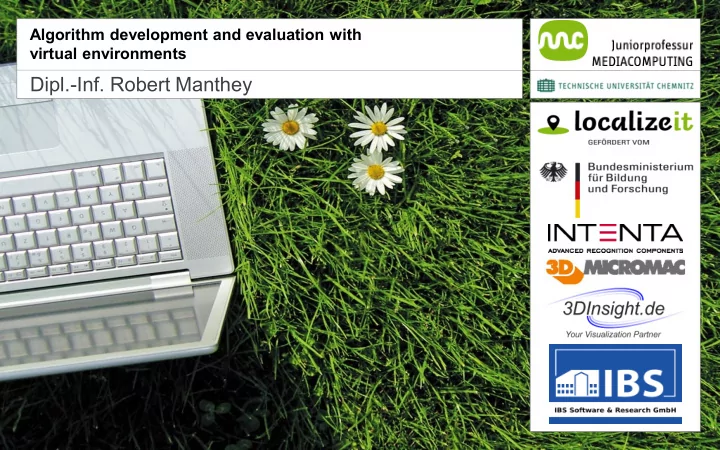

Algorithm development and evaluation with virtual environments Dipl.-Inf. Robert Manthey Dipl.-Inf. Robert Manthey 15. November 2017 1
Dipl.-Inf. Robert Manthey • 2008: Univerity degree in computer science at Technical University of Chemnitz • Since 2008: Different software projects at database management, ergonomics, facility-and-school safety, automotive embedded system testing, media processing and image understanding • 2017: Guest research at NIST [1] Dipl.-Inf. Robert Manthey 15. November 2017 2
Background & Problems (I) Solving a problem need a Algorithm to process the Data and handle the Constraints in given Environment . BUT Dipl.-Inf. Robert Manthey 15. November 2017 3
Background & Problems (II) Solving a problem need a Algorithm to process the Data and handle the Constraints in given Environment . BUT Verifications, Evaluations and Competitions need similar elements. Dipl.-Inf. Robert Manthey 15. November 2017 4
? Background & Problems (III) Often only Algorithm , Data and related informations being provided. BUT, no informations of • Environment -dependencies to external programs or libraries, environment variable settings, functions from older versions of source code etc. • Constraints to specific libraries, certain hardware/ GPU, parameter settings etc. Much “Debugging“ needed Dipl.-Inf. Robert Manthey 15. November 2017 5
Virtual Machines Virtual Machines provide: • Predefined setup of external programs, environment variables, libraries and parameters • Different levels of hardware and system abstraction • Easy to provide and to share • Increase reproducibility Dipl.-Inf. Robert Manthey 15. November 2017 6
VM - Xen [2] • Hypervisor between hardware and OS • Slight overhead • Good isolation of host and guests • Each guest with own hardware driver possible • Complex configuration • Consumer GPU/CUDA limitations Dipl.-Inf. Robert Manthey 15. November 2017 7
VM - KVM [3] • Hypervisor between host OS and guests • Slightly more overhead • Good isolation of host and guests • Each guest with own paravirtual hardware driver possible • Easier and flexible configuration • Consumer GPU/CUDA limitations Dipl.-Inf. Robert Manthey 15. November 2017 8
VM - Docker (I) [4] • Hypervisor between host control application and guests processes • Slightly more overhead • Isolation of processes, libraries and user environments • Guests share kernel, drivers and host resources ( Linux only) • Simple and flexible configuration Dipl.-Inf. Robert Manthey 15. November 2017 9
VM - Docker (II) • Guest creation possible with: • Version control • Inheritance from existing image • Easy setup of guest configuration and environment • Reproducability • On Linux, GPU access through host driver on Linux with nvidia-docker [5] Dipl.-Inf. Robert Manthey 15. November 2017 10
VM - Docker (III) Dipl.-Inf. Robert Manthey 15. November 2017 11
? VM - Docker (IV) Dipl.-Inf. Robert Manthey 15. November 2017 12
Example - Openpose [6] Dipl.-Inf. Robert Manthey 15. November 2017 13
Summary • Virtual maschines provide different granularity of isolation and abstraction from other guests and hardware (GPU) • Virtual maschines provide clean, easy to share, reproducable, scalable and fast environments for development, verification and evaluation of algorithm and systems • Can prevent unneeded debugging Thank you for your attention. Any questions? Dipl.-Inf. Robert Manthey 15. November 2017 14
References 1. https://www.explainxkcd.com/wiki/index.php/1722:_Debugging 2. https://www.xenproject.org/ 3. https://www.linux-kvm.org/ 4. https://www.docker.com/ 5. https://github.com/NVIDIA/nvidia-docker/wiki 6. https://github.com/CMU-Perceptual-Computing-Lab/openpose Dipl.-Inf. Robert Manthey 15. November 2017 15
Recommend
More recommend